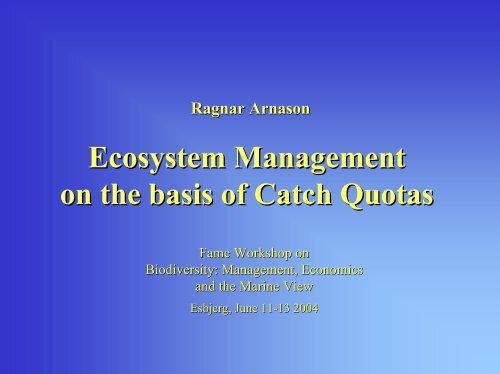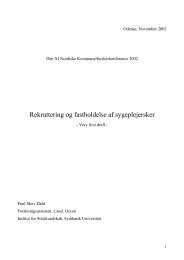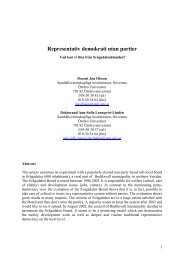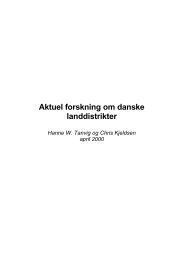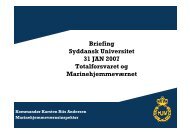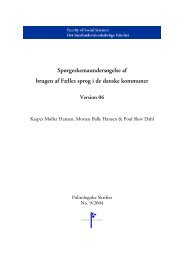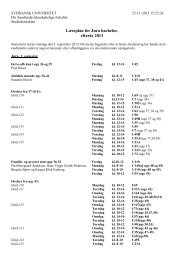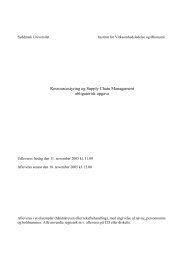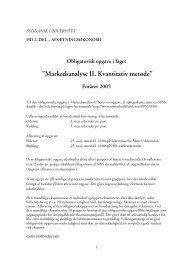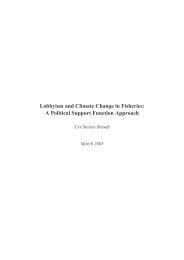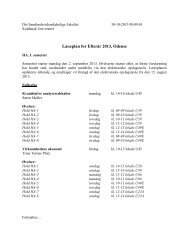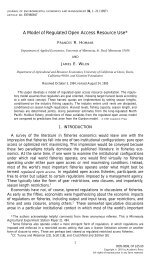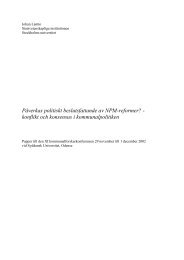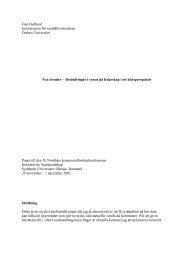(PowerPoint) - By Ragnar Arnason
(PowerPoint) - By Ragnar Arnason
(PowerPoint) - By Ragnar Arnason
You also want an ePaper? Increase the reach of your titles
YUMPU automatically turns print PDFs into web optimized ePapers that Google loves.
<strong>Ragnar</strong> <strong>Arnason</strong><br />
Ecosystem Management<br />
on the basis of Catch Quotas<br />
Fame Workshop on<br />
Biodiversity: Management, Economics<br />
and the Marine View<br />
Esbjerg, June 11-13 13 2004
Topic:<br />
Ecosystem Fisheries<br />
Approach:<br />
1. General Modelling<br />
2. Optimal Ecosystem Use<br />
3. Ecosystem Management<br />
An example of a marked-based instruments<br />
to solve environmental problems<br />
(Complements yesterday’s talks)
Modelling
The Ecosystem<br />
• Ecosystem consists of<br />
(i) Aquatic biota (living (renewable) resources)<br />
(ii) Habitat (nonliving physical environment)<br />
• I species<br />
• Each species measured by a single<br />
variable, x (biomass)<br />
• H habitat variables, z
Basic Ecosystem Equation<br />
&x<br />
=<br />
G( x, z)<br />
x = ( x , x ,.... x )<br />
1 2<br />
∂x<br />
∂x ∂x ∂x<br />
x&<br />
= =<br />
∂t ∂t ∂t ∂t<br />
z = ( z , z ,... z )<br />
1 2<br />
I<br />
1 2<br />
I<br />
( , ,....., )<br />
H<br />
Gxz xz xz xz<br />
1 2<br />
I<br />
( , ) = ( G ( , ), G ( , ),..., G ( , ))
Assumptions<br />
1. For each species i, ∃ x>0 and z such that<br />
its biomass growth is positive<br />
2. Each biomass growth function is twice<br />
continuously differentiable and concave<br />
3. Each biomass growth function is dome-<br />
shaped in its own biomass
More formally:<br />
i<br />
For all i, ∃ x > 0 , x st . . G ( x, z) > 0<br />
i<br />
The derivatives, G
A typical biomass growth function<br />
Biomass<br />
growth,<br />
G i (x)<br />
[x´]<br />
[x´´]<br />
x i
The Community Matrix<br />
(An (I×I)(<br />
I) non-symmetric matrix<br />
of marginal interaction terms)<br />
G<br />
x<br />
( x)<br />
1 1<br />
⎛Gx<br />
. . G ⎞<br />
1<br />
xI<br />
⎜<br />
⎟<br />
2<br />
∂G( x)<br />
⎜ . G<br />
x<br />
. ⎟<br />
∂x<br />
⎜ . . . ⎟<br />
⎜<br />
I<br />
I<br />
Gx<br />
. . G ⎟<br />
⎝ 1<br />
xI<br />
⎠<br />
2<br />
≡ = ⎜ ⎟<br />
i i<br />
Note: G ≡ G ( x),<br />
i.e. the interaction terms, are functions of biomass<br />
x<br />
j<br />
x<br />
j
If the community matrix is diagonal..<br />
Gx<br />
( x)<br />
⎛G<br />
⎜<br />
⎜<br />
1<br />
x<br />
1<br />
0 . 0<br />
2<br />
0 Gx<br />
0 .<br />
2<br />
= ⎜ ⎟<br />
⎜<br />
⎜<br />
⎝<br />
. 0 . 0<br />
0 . 0<br />
G<br />
I<br />
x<br />
I<br />
⎞<br />
⎟<br />
⎟<br />
⎟<br />
⎟<br />
⎠<br />
....then there are no interspecies,<br />
ecological effects
Important things to notice about the<br />
ecosystem equation &x = G( x, z)<br />
1. It may (and probably will) exhibit multiple<br />
equilibria<br />
2. It may easily exhibit complicated<br />
dynamics<br />
(1) Strange attractors<br />
(2) Bifurcations<br />
(3) Chaos
Illustration of multiple equilibria<br />
alpha⋅x<br />
− beta⋅x 2<br />
ay ⋅ − by ⋅<br />
2<br />
4<br />
− cx ⋅ 0<br />
− gamma⋅<br />
y 0<br />
gamma = -1, c = 1<br />
=> x prays on y<br />
Locally<br />
stable<br />
Fxx ( )<br />
Hxx ( )<br />
y<br />
HH( xx)<br />
− 2<br />
0<br />
0 2 4<br />
0 xx<br />
Saddle<br />
point<br />
4
Species interactions creating chaos<br />
- A very simple example -<br />
x − t 1<br />
x = t<br />
a ⋅ x ⋅ + t<br />
(1 − b ⋅ xt)<br />
3<br />
y − 1<br />
y = α ⋅ x ⋅ (1 − +<br />
β ⋅ x ) − γ ⋅ y ⋅ x<br />
t t t t t t<br />
a=1.5 α=2.0<br />
b=0.5 β=0.5<br />
γ = ?
Dynamics<br />
γ = 0<br />
γ = 0.233<br />
2.067<br />
3<br />
2.067<br />
3<br />
2<br />
2<br />
1<br />
1<br />
0.8<br />
x i<br />
200<br />
0<br />
0 100 200<br />
0.8<br />
x i<br />
200<br />
0<br />
0 100 200<br />
1 i<br />
1 i<br />
3<br />
3<br />
3<br />
2<br />
2<br />
1<br />
1<br />
0 50 100<br />
1 i<br />
100<br />
y i<br />
0.039<br />
y i<br />
100<br />
0<br />
0 50 100<br />
1 i
Harvesting Activity<br />
• Harvesting sector consists of<br />
(i)<br />
N harvesting firms (here aggregated)<br />
(ii) Rest of the economy<br />
• Rest of the economy represented by prices<br />
(assumed to be constant => not a GE model)
Fishing effort<br />
Vector of species directed fishing effort<br />
e = (e 1 ,e 2 ,....e I )<br />
• If the e i s can be freely selected, we have<br />
perfect targetting<br />
• If not, e.g. e i = F(e j ) ..etc, we have<br />
limited targetting.
Harvesting function<br />
i<br />
y = Y ( ex , ), i = 1, 2,... I<br />
i<br />
∂Y<br />
∂x<br />
∂Y<br />
∂e<br />
i<br />
j<br />
j<br />
i<br />
≠<br />
≠<br />
0, cross species stock effects<br />
0, by-catch<br />
y<br />
= Yex (, )
Biomass Evolution<br />
&x = G( x, z) −Y( e, x)<br />
i<br />
i<br />
x& = G ( xz , ) −Y ( ex , ), i=1,2,...<br />
I<br />
i
Cost Function<br />
i<br />
c = C ( ew , ), i = 1, 2,... I<br />
i<br />
∂C<br />
∂e<br />
j<br />
i<br />
≠<br />
0, production externality<br />
c=C( e,w)
Profits<br />
i<br />
i<br />
π<br />
i<br />
= Y ( ex , ) − C ( ew , ), i = 1, 2,... I<br />
π = Yex (, ) − Ce,w ( )<br />
I<br />
i<br />
i<br />
π = π = Y (, ) −C<br />
(, )<br />
i<br />
i= 1 i=<br />
1<br />
I<br />
∑ ∑ ex ew<br />
= 1⋅( Yex ( , ) − Cew ( , )) = 1⋅π
Present value of profits<br />
∞<br />
−rt<br />
⋅<br />
−rt<br />
⋅<br />
V = π ⋅ e dt = 1⋅( Yex ( , ) −Cew<br />
( , )) ⋅e dt<br />
∫ ∫<br />
0 0<br />
∞
Optimal Ecosystem Use
Optimal Ecosystem Fisheries<br />
−rt<br />
⋅<br />
−rt<br />
⋅<br />
Max V = π ⋅ e dt = ⋅( Yex ( , ) −Cew<br />
( , )) ⋅e dt<br />
{} e<br />
∞<br />
0 0<br />
∞<br />
∫ ∫ 1<br />
Such that &x = G( x) -Y( e,x)<br />
e ≥ 0<br />
x ≥ 0
Necessary Conditions<br />
(Assuming e, x>0) x<br />
H = λ 0<br />
⋅1⋅( Y( e, x) − C( e, w)) + λ ⋅( G( x) -Y( e,x))<br />
λ<br />
0<br />
= 1<br />
1<br />
e e<br />
⋅Π − λ ⋅Y<br />
=<br />
λ&<br />
−r<br />
⋅ λ=−1⋅Y −λ⋅(<br />
G −Y<br />
0<br />
x x x<br />
)<br />
&x<br />
=<br />
G( x) -Y( e,x)<br />
(3⋅I conditions to determine 3 ⋅I unknowns)
Interpretation<br />
Rule for optimal vector of fishing effort at each<br />
point of time:<br />
⋅Π − λ ⋅Y<br />
= 0<br />
1<br />
e e<br />
Rule for determining the vector of shadow values<br />
of biomass:<br />
λ&<br />
−r<br />
⋅ λ=−1⋅<br />
−λ⋅(<br />
−<br />
Y G Y<br />
x x x<br />
)
Note!<br />
• Single species solutions are appropriate<br />
only if all four (I×I)(<br />
) matrices;<br />
Y e , Y x , C e and G x<br />
are diagonal!<br />
Theorem<br />
Even when there are no ecosystem interactions,<br />
economic interactions (bycatch, cross stock<br />
externalities and production externalities) will<br />
generate similar complexities
Concentrated Solution<br />
λ&<br />
=− 1⋅Y + λ⋅ ( Y + r ⋅I<br />
−G<br />
x x x<br />
),<br />
λ =<br />
1<br />
e e<br />
⋅Π ⋅( Y ) −1<br />
&x<br />
=<br />
G( x) -Y( e,x)<br />
This system of 2⋅I2<br />
differential equations may<br />
exhibit very complex dynamics!<br />
(incl. multiple equilibria, , strange attractors and chaos)
Equilibrium equations<br />
x&<br />
= e&<br />
= 0<br />
λ Π I<br />
1<br />
⋅ [ G ( ) −<br />
x<br />
+ Ce⋅ e<br />
⋅Yx<br />
−r<br />
⋅ ) = 0<br />
λ =<br />
1<br />
e e<br />
⋅Π ⋅( Y ) −1<br />
G( x) -Y( e,x) = 0
Properties of equilibrium<br />
1. There may be many solutions (equilibria(<br />
equilibria)<br />
2. The stability properties of these equilibria may<br />
be of many kinds<br />
3. In the single species case, I=1, the system<br />
reduces to the usual Clark-Munro equilibrium<br />
solution<br />
Ce⋅Yx<br />
Gx ( ) + = r<br />
π<br />
Gx ( ) − Yex ( , ) = 0<br />
e
Properties of equilibrium ...cont.<br />
4. If (and only if) all the Jacobian matrices, Y e , Y x , C e<br />
and G x are diagonal, the equilibrium system<br />
reduces to a collection of Clark-Munro single<br />
species equilibrium expressions.<br />
5. The shadow values of biomass, λs, do not have to<br />
be positive!
Example of equilibrium<br />
Two species<br />
λ Π I<br />
1<br />
⋅ [ G ( ) −<br />
x<br />
+ Ce⋅ e<br />
⋅Yx<br />
−r<br />
⋅ ) = 0<br />
1 1 1 1 1 1<br />
−1<br />
⎛<br />
1 1<br />
⎛Gx G ⎞ ⎛<br />
x<br />
Ce C ⎞ ⎛<br />
e<br />
Πe Π ⎞ ⎛<br />
e<br />
Yx Y ⎞<br />
x 1 0<br />
⎞<br />
⎛ ⎞<br />
⋅ ⎜ + ⋅ ⋅ −r<br />
⋅ ⎟=<br />
1 2 1 2 1 2 1 2<br />
( λ1, λ2) 0<br />
2 2 2 2 2 2 2 2<br />
⎜⎜G 0 1<br />
x<br />
G ⎟ ⎜<br />
1 x<br />
C<br />
2 e<br />
C ⎟ ⎜ ⎟ ⎜ ⎜ ⎟<br />
1 e2 e1 e<br />
Y<br />
2 x<br />
Y ⎟ ⎟<br />
⎝ ⎠ ⎝ ⎠ ⎝<br />
Π Π<br />
⎠ ⎝ 1 x ⎝ ⎠<br />
2 ⎠<br />
⎝<br />
λ<br />
G + Ψ + ( G + Ψ ) ⋅ = r,<br />
λ<br />
1 1 2 2 2<br />
x1 1 x1<br />
1<br />
1<br />
λ<br />
G + Ψ + ( G + Ψ ) ⋅ = r<br />
2 2 1 1 1<br />
x2 2 x2<br />
2<br />
λ<br />
2<br />
⎠<br />
where<br />
⎛<br />
1 1 1 1<br />
−1<br />
1 1<br />
1 1<br />
Ψ Ψ ⎞ Ce Ce Πe Πe Yx Yx<br />
≡ ⋅ ⋅<br />
⎛ ⎞ ⎛ ⎞ ⎛ ⎞<br />
1 ¨2<br />
1 2 1 2 1 2<br />
⎜ 2 2 ⎟<br />
2 2 2 2 2 2<br />
⎝Ψ1 Ψ2<br />
⎠<br />
⎜Ce C ⎟ ⎜ ⎟ ⎜<br />
1 e2 e1 e<br />
Y<br />
2 x<br />
Y ⎟<br />
⎝ ⎠ ⎝<br />
Π Π<br />
⎠ ⎝ 1 x2<br />
⎠
Ecosystem Management
Behaviour<br />
Optimal<br />
1<br />
e e<br />
⋅Π − λ ⋅Y<br />
=<br />
I<br />
I<br />
i i i i<br />
ej ej ∑λ<br />
ej<br />
i= 1 i=<br />
1<br />
∑<br />
( Y −C ) − ⋅ Y = 0, j = 1, 2,... I<br />
0<br />
Common Property<br />
⋅Π =0 1<br />
e<br />
So, the management problem is to<br />
impose the shadow prices, λ i s !
Taxes<br />
Optimal shadow prices:<br />
Define the tax (on harvest):<br />
λ =<br />
τ =<br />
⋅Π ⋅( Y ) −1<br />
1<br />
e e<br />
⋅Π ⋅( Y ) −1<br />
1<br />
e e<br />
Profits become:<br />
1⋅Π(, ex) −τ ⋅Y( e,x)<br />
Behaviour becomes: 1⋅Π − τ ⋅Y<br />
= 1⋅Π − λ⋅Y<br />
= 0<br />
e e e e<br />
Optimal!
Problem<br />
The optimal tax vector depends on e* and x*<br />
τ = Y F x e<br />
parameters<br />
−1<br />
1⋅Πe⋅ (<br />
e) = ( *, *, )<br />
Therefore to calculate the optimal tax, one must<br />
first solve the dynamic optimization problem<br />
This is a hard task indeed!!
An ITQ system<br />
1. Fishing firms hold fractions of the TAC for each<br />
species: Share quotas, α(i,t)<br />
2. The share quotas are permanent assets<br />
3. “Annual” catch quota: q(i,t)= α(i,t)⋅TAC(t)<br />
4. Both types of quotas are divisible and tradable ⇒<br />
(i)<br />
quota holdings can be adjusted over time<br />
(ii) there will be quota prices<br />
5. Fisheries authorities decide on<br />
(i)<br />
initial allocation of share quotas<br />
(ii) total allowable catches “annually” TAC(t)
Quota prices<br />
• Under this ITQ system, the quotas (both catch quotas<br />
and the share quotas) will have a price<br />
• Let s be the price of the catch quota<br />
• Note that s can be negative!<br />
• Now, s represents the opportunity cost of harvest<br />
(just as a tax or a shadow value)<br />
• It follows that behaviour will be:<br />
1<br />
e e<br />
⋅Π − sY ⋅ =<br />
0
Optimal behaviour under ITQs<br />
• If s=λ ⇒ behaviour will be optimal!<br />
• But s depends on the<br />
vector of TACs (the<br />
total allowable catches)!<br />
s<br />
TAC<br />
⇒ <strong>By</strong> setting the right TACs the quota authority<br />
will induce the optimal fishing behaviour
How to set the right TAC?<br />
• To calculate the right TAC requires solving the<br />
dynamic maximization problem<br />
• Not really feasible<br />
• However, the best knowledge about the conditions<br />
of the fishery and thus the “best” possible TAC<br />
resides within the fishing industry<br />
• This information is revealed in permanent quota<br />
prices!!
I<br />
∑<br />
i=<br />
1<br />
Can show that:<br />
∞<br />
−rt<br />
Si<br />
= 1⋅ S = ∫ 1⋅π<br />
⋅e dt<br />
0<br />
S = Share quota price<br />
Theorem<br />
Permanent quota prices equal<br />
expected present value of profits in<br />
the fisheries
So in order to find the “best” TAC,<br />
the quota authority only has to play<br />
around with the TACs !!
Example for one species<br />
Quota values,<br />
resource<br />
rents<br />
Total allowable catch, TAC
Example for two species<br />
Quota<br />
value<br />
TAC 2<br />
M<br />
TAC 1
Will this work?<br />
1. Needs well functioning quota markets<br />
2. Will not be fully optimal (unless<br />
information is perfect)<br />
3. It will be as good as socially possible, i.e.<br />
it will use (and generate) information<br />
efficiently<br />
[Market arbitrage arguments]
Optimal ecosystem fisheries<br />
(Probable outcome)<br />
Quota price<br />
Total Quota, TAC<br />
Negative<br />
(i.e., stock enhancement)<br />
Positive<br />
(i.e., fishery)<br />
Negative<br />
Positive<br />
Unprofitable stock<br />
enhancement<br />
(subsidized releases)<br />
Profitable stock<br />
enhancement<br />
(ocean ranching)<br />
Unprofitable fishery<br />
(subsidized removal<br />
of predators/competitors)<br />
Profitable fishery<br />
(Commercial fishery)
Summary<br />
1. Ecosystems are exceedingly complex<br />
2. There is virtually no chance that empirical<br />
research will reveal their structure within our<br />
lifetimes<br />
3. It follows that sensible management is very<br />
difficult to achieve<br />
– Akin to groping in the dark<br />
– Decision making under extreme uncertainty and very<br />
high risk.
Summary ....cont.<br />
4. Under these circumstances centralized<br />
management is particularly unattractive<br />
– Inappropriate incentives<br />
– Information collection and processing<br />
5. Decentralized decision making collects and<br />
processes available information much better<br />
– Cf. the market system<br />
6. Ecosystem ITQs greatly facilitate dealing with<br />
this ecosystem uses.
Summary ....cont.<br />
7. Analysis of the workings of ecosystem ITQs<br />
reveals unexpected fisheries management<br />
outcomes<br />
8. Similar approach should apply in natural<br />
resource use in general, .....provided<br />
sufficiently<br />
high quality property rights can be defined and<br />
enforced.<br />
9. This approach does not apply in the case of<br />
environmental public goods.<br />
(In fact, it’s hard to see that market-based approaches<br />
can apply to such to public goods at all)
Strange attractors: Lorenz attractor


